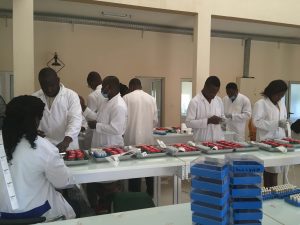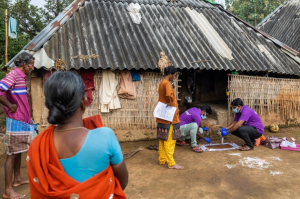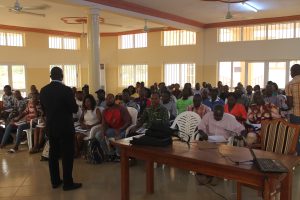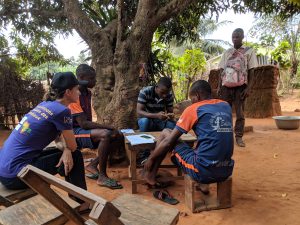Objectives
We hypothesize three years of community-wide mass drug administration (MDA) treatment with the deworming drug albendazole will be sufficient to interrupt transmission of each individual species in the same areas, whereas programs targeted at pre-school and school-age children will not achieve such interruption.
1. Defining soil-transmitted helminths (STH) transmission interruption
In order to quantify epidemiologic and operational targets for soil-transmitted helminth (STH) transmission interruption, we have established a series of studies to:
- Define an STH transmission breakpoint
- Develop the tools and methods necessary to operationally measure STH transmission interruption
- Identify the prevalence and intensity of STH in an area believed to have achieved STH elimination
History indicates that interruption of STH transmission may be possible. Specifically, STHs were previously highly prevalent in the southeastern United States, South Korea and Japan and sustained control efforts may have led to the interruption of STH transmission in all of these contexts.
DeWorm3, in partnership with Nagasaki University, is conducting targeted prevalence surveys in Nagasaki Prefecture to identify potential persistent STH infections, correlates of infection, and factors influencing community member participation in STH prevalence surveys in areas considered to be at minimal risk.
In order to define an STH transmission breakpoint in areas with active STH transmission, partners at the Imperial College London have conducted several groundbreaking mathematical modeling studies. These studies have been used to inform identification of: an optimal intervention (community-wide twice-yearly mass drug administration [MDA]), target benchmarks for age-stratified treatment coverage, and a prevalence threshold of 2% after which it is believed that sustained transmission will no longer be possible.
Mathematical models indicate that high treatment compliance is critical for interrupting disease transmission. In collaboration with the Centro de Investigación Veterinaria de Tandil (CIVETAN), the DeWorm3 Project is developing a urinary assay to measure albendazole metabolites. The assay will be utilized during DeWorm3 clinical trial coverage surveys to validate reported treatment coverage.
In low transmission settings with a majority of low intensity infections, it is crucial to apply diagnostic methods with the highest sensitivity to successfully detect all remaining infections. In collaboration with Smith College, the DeWorm3 project identified the best ways of preserving stool for subsequent molecular evaluation by qPCR and developed pooling strategies which help to reduce cost and enhance feasibility of molecular testing at site level.
2. Demonstrate the feasibility of interrupting STH transmission through MDA-based approaches in settings where lymphatic filariasis (LF) programs have progressed to post-MDA surveillance
In order to test the feasibility of interrupting the transmission of STH, we are conducting a series of community, cluster-randomized trials in Benin, India, and Malawi.
Lymphatic filariasis (LF) programs delivered at least five years of community-wide mass drug administration (MDA) with albendazole in DeWorm3 sites and have successfully transitioned to post-MDA surveillance status in each area. This epidemiological setting provides an opportunity to leverage the success of the LF programs to understand how further intensified drug pressure influences the feasibility of interrupting the transmission of STH.
DeWorm3 study sites have 80,000-100,000 inhabitants per site, with 40 clusters of 1,650-4,000 inhabitants each. Clusters randomized to the intervention arm of the trial receive twice yearly community-wide MDA targeting eligible individuals of all ages. Clusters randomized to the control arm of the trial receive the country’s standard of care treatment targeting pre-school and school-age children. Treatment will be delivered for three years, and will be followed by two years of surveillance during which no MDA will take place in either trial arm in order to monitor for infection recrudescence.
Exhaustive population censuses and school-facility surveys are conducted at study baseline and updated annually to identify all individuals living in the study sites and key STH risk factors present at individual, household, and school levels.
STH prevalence is determined via cross-sectional surveys at study baseline, 6 months following the final round of MDA, and 24 months following the final round of MDA (i.e. post surveillance). Longitudinal surveys are also conducted to ascertain infection and reinfection patterns within the same cohort of individuals over time. A random selection of stool samples are examined via duplicate Kato-Katz and all samples are examined for STH genetic material via quantitative PCR, which is a key strength of the study given the low prevalence expected after multiple years of intensified MDA.
3. Recommend a feasible and effective approach for scaling STH transmission interruption programs
DeWorm3 is a hybrid trial, in which both clinical and implementation outcomes are addressed. The primary purpose of conducting a hybrid trial is to:
- Identify opportunities to maximize program delivery while maintaining fidelity to the randomized intervention
- Contextualize clinical trial findings within the operational and health systems landscape
- Generate evidence regarding opportunities to sustain or scale-up successful mass drug administration (MDA) delivery strategies
Led by the University of Washington, a number of implementation science studies are taking place in DeWorm3 to address distinct and complementary questions.
Stakeholder mapping and accompanying network analysis are used to identify the stakeholders influencing and affected by community-wide MDA and school-age-targeted MDA. Through the characterization of stakeholder influence and relationships, opportunities for change management or facilitation of effective, sustainable improvements to delivery are identified.
Within DeWorm3 qualitative research studies, individual interviews and focus groups are conducted at trial baseline, midline, and endline in order to understand barriers and facilitators to delivering community-wide MDA for STH and opportunities to optimize disease elimination campaigns more generally. In order to identify system capacity, flexibility, and commitment to potential changes in STH delivery platforms, structural readiness scores are constructed based on surveys with a wide array of stakeholders and changes in readiness are tracked over time.
Operations research is also used in DeWorm3 via intensive process mapping of activities needed to implement STH MDA with high coverage, providing evidence regarding activities that are instrumental to effective programs.
Lastly, economic evaluations are a key component of DeWorm3 implementation science research. In collaboration with the Economic Analysis support unit at the Swiss Tropical & Public Health Institute, financial and economic costs are routinely collected in trial sites to identify the relative cost-effectiveness of the DeWorm3 intervention as compared to the standard of care, both over the short-term and longer-term elimination-specific time horizons. Together, these studies contribute to the objective of identifying sustainable and scalable models for STH transmission interruption.





